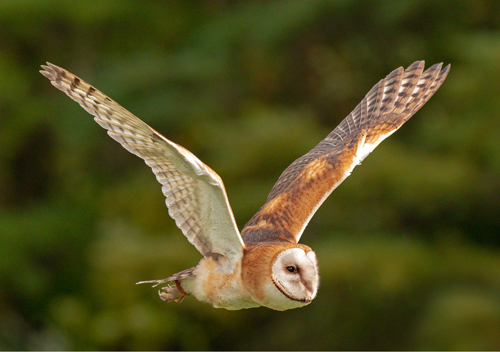Environment
Barn owls

The barn owl is a stunningly beautiful bird with golden buff coloured upper parts laced with silver grey and white under-parts. It has a distinctive white heart shaped face and when seen in flight the overall impression is of a large white bird. The flight is buoyant and graceful, the wings span 85cm.
Barn owls shriek and hiss, they don’t hoot – that’s the tawny owl.
Barn owls hunt mainly from the air (rather than from a perch) and have some amazing adaptations enabling them to find and catch small mammals hidden in deep vegetation in the dark. They don’t generally venture into dense woodland but will forage over any open habitat that supports a population of small mammals. Barn owls may roost or nest in any structure or tree that meets their requirements.
Barn owl pellets
Barn owls generally swallow their prey whole but are unable to digest the hair and bone. After each night’s hunting the owl regurgitates 1 or 2 black pellets containing the remains of 4 or 5 small mammals. In dry well-used roost sites lots of barn owl pellets can accumulate and it is possible to work out how recently the owl was present.
In the UK the most frequently taken prey is the field vole, microtus agrestis (also known as the short-tailed vole) usually forming between 40% and 80% of the diet. In most diets, the long-tailed field mouse, apodemus sylvaticus, also known as the wood mouse or common shrew, sorex araneus is the second most frequently taken.
Barn owls in decline
There is little doubt that the main factors are:
- Low food availability due to intensive farming
- Road mortality, especially dispersing juveniles on trunk roads
- Loss of traditional roost and nest sites
- Possibly the effects of secondary poisoning by rodenticides
- Since 2009, increased frequency of extreme weather events
Ways to encourage wild barn owls
- Manage land for barn owls
- The best foraging habitat is rough grassland with a high population of field voles
- Provide a roosting and nesting place
- Well designed and well positioned barn owl nest boxes are perfect places for them to hide, roost, and nest
- Avoid using rat poison, known as rodenticides
- 84 to 91% of wild barn owls contain rat poison. Some die as a direct result, while low-level contamination may affect hunting and breeding success
Help your local barn owl group
- Most counties have an independent voluntary Barn Owl Group or an individual actively involved in barn owl conservation. Some of these seek public support and welcome new helpers
- Object to damaging rural developments
- Careful development with provision for barn owls can help protect and secure the long-term future of a nest site
- Help minimise climate change by insulating your home
- For example, buy energy-efficient appliances, switch off electronics at the wall, walk, cycle or use public transport, holiday closer to home
To encourage barn owls in the district, Countrycare erected 2 barn owl boxes on one of its nature reserves. They were made by local wildlife enthusiast, the late Colin Thompson.
